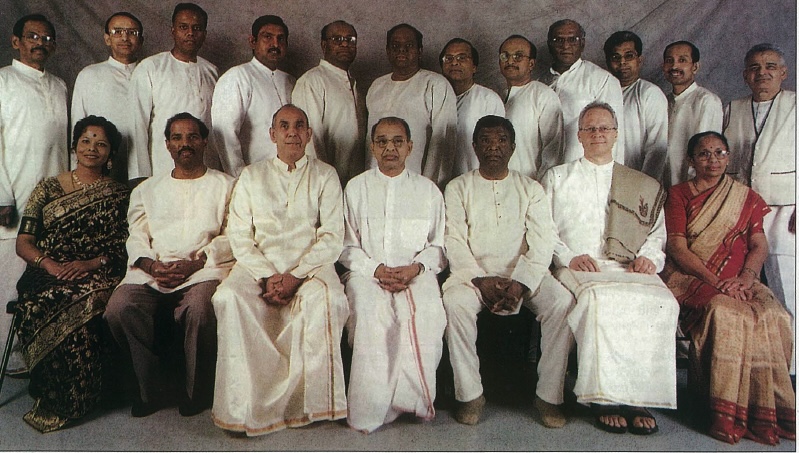It’s cold, really cold–that’s an equatorial-dwelling Sri Lankan Tamil’s first and everlasting impression of Edmonton, Albert, Canada. D. Selvarajah remembers the cold oh-so-well ever since he arrived in Edmonton in 1974, the first of a steady stream of Sri Lankan Tamils to move to the capital of Alberta, Canada’s second-most Western province. Edmonton was booming at the time, spurred on by the development of methods to extract petroleum from the vast oil sand deposits to the North. Farsighted Hindu families in Sri Lanka marshalled their resources to send promising members to this and other countries where they could build a future more secure and prosperous than any they thought possible in the poor economic climate of their native country. The end for Selvarajah came when he had to line up in Sri Lanka for everything, even just to buy baby food for his two-year-old son. The political situation was still stable, but there was decided uncertainty about the future.
Selvarajah wasn’t thrilled with Edmonton’s climate, but he was certainly impressed by the citizens, and to this day says he’s never experienced discrimination and always found the Canadians a friendly, helpful and accommodating people. Here, he felt, was the place he should raise his son. In 1975, he told Hinduism Today, a few more people came, generally engineers and technicians. By the time the anti-Tamil riots took the lives of hundreds in Colombo in 1983, some thirty or so families had already moved to Edmonton. Canada saw a huge influx of refugees following the riots and maintained an open-door policy toward Sri Lankans for many years. Some of those refugees came to Edmonton, but all of them eventually moved on to Toronto where the vast majority of Sri Lankan Tamils were settling–so many that Toronto is their largest settlement outside Sri Lanka.
In 1978, when the community was still at 25 families, they decided to gather monthly for bhajana, singing religious songs together. In that year, Satguru Sivaya Subramuniyaswami, publisher of Hinduism Today, flew there and gifted the community a small Lord Ganesha stone icon for worship. The initiated successor of the famed Sage Yogaswami of Jaffna, Sri Lanka, Subramuniyaswami is the hereditary guru of the now largely dispersed Jaffna Tamil Hindus. As such, he has inspired and guided the construction of dozens of temples in this community in countries all over the world, including the USA, UK, Germany, Finland, Australia and New Zealand.
Though the group was small–even now there are just 60 Sri Lankan Tamil families in Edmonton–they decided to build their own temple, following the traditions of worship from Sri Lanka. Land was acquired in 1985 and paid off a year later. A plan for a 10,000-square-foot temple was proposed. In 1987 Sri Subramania Iyer of Sri Lanka was hired as the permanent priest for the temple. He had been serving at a temple in Singapore and found the transition from one of the world’s most densely populated cities to the single house on the temple property in a rural area with few neighbors a challenge–not to mention the winter weather! In 1994, he was authorized to conduct marriages by the Province of Alberta.
By 1994, the project had stalled. The temple board decided to adjust the design to something within their means. They halved the floor space and switched to all concrete instead of part imported stonework. The project picked up immediately and in 1995 got a tremendous boost when their Lord Ganesha icon started drinking milk on September 22, as He was doing all over the world during the “Milk Miracle.” Devotees lined up to offer milk, with the miracle continuing through the weekend.
The temple also took advantage of a unique fund-raising opportunity provided to nonprofits by the Province of Alberta. The government owns a gambling casino which they allow to be run for two nights by qualified nonprofit organizations in turn on a two-year cycle. There was debate among the trustees whether to follow this lucrative route, but Subramuniyaswami gave his reluctant permission in consideration of the community’s small size and limited resources. The revenues from this has provided up to can$50,000 per year for about ten years.
Finally, on July 7, 2000, the temple held its kumbhabhishekam, the grand opening and blessing of the completed structure and installation of all Deities. Hundreds attended, and local news coverage was favorable–the reporters especially liked the ceremonial participation of Jenna the calf, on loan from a local farm. “In front of the temple’s sanctuary,” wrote the Edmonton Journal, “the skittish Jenna was blessed by Swami Visvanatha Kurukkal, a senior priest who had flown in from Sri Lanka just for the ceremony. He fed Jenna some ceremonial food and smiled at her. Seemingly charmed, the calf batted her long eyelashes and grew placid. The crowd laughed good naturedly.”
Selvarajah is concerned about maintaining the temple according to the traditions of Sri Lanka, something stipulated in the temple’s constitution. A requirement for membership is a declaration that the person is a “Saivite Hindu.” It’s a specific declaration of belief unusual for a Hindu temple, but the norm for Christian churches who wish to maintain their denomination’s tradition. All of Edmonton’s Hindus enthusiastically support the temple, cold winters and all.
Maha Ganapati Temple, 128 Running Creek Road, Edmonton, Alberta, Canada
